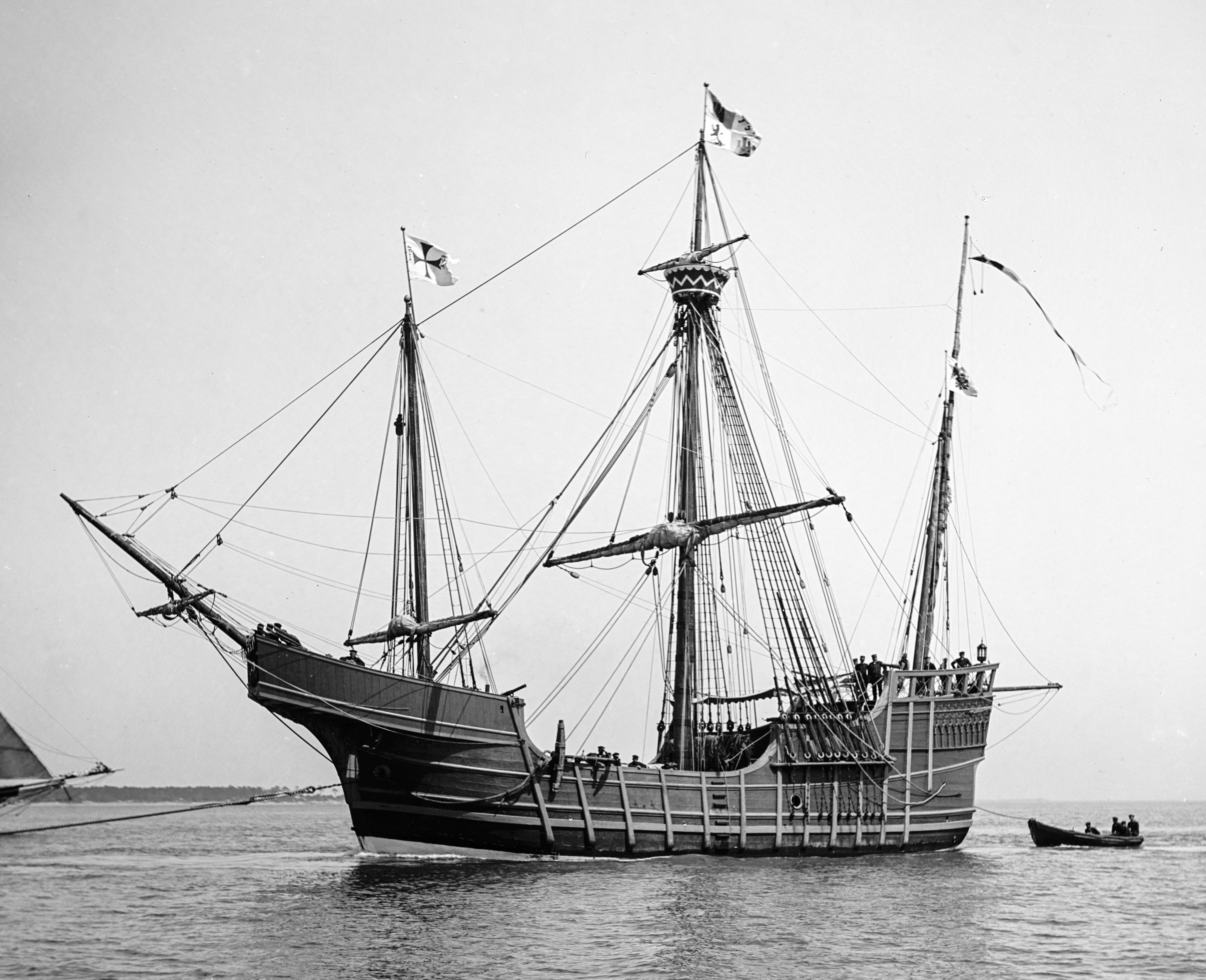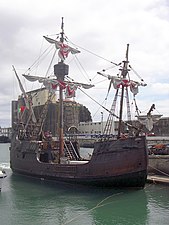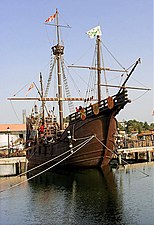
Santa María (ship)
La Santa María de la Inmaculada Concepción (Spanish: [la ˈsãn̪.t̪a maˈɾi.a ð̞e̞ la ĩm.ma.kuˈla.ð̞a kõn̟.θeβ̞ˈθjõn] lit. 'The Holy Mary of the Immaculate Conception'), or La Santa María (Spanish: [la ˈsãn̪.t̪a maˈɾi.a]), originally La Gallega (Spanish: [la ɡaˈʝe.ɣ̞a]), was the largest of the three small ships used by Christopher Columbus in his first expedition across the Atlantic Ocean in 1492, with the backing of the Spanish monarchs. Her master and owner was Juan de la Cosa.
History[edit]
Santa María was built in Pontevedra, Galicia.[1][2] Santa María was a medium-sized commercial nau or carrack, about 58 ft (17.7 m) long on deck, and according to Juan Escalante de Mendoza in 1575, Santa Maria was "very little larger than 100 toneladas" (about 100 tons, or tuns) burthen, or burden,[3][4][5] and was used as the flagship for the expedition. Santa María had a single deck and three small masts.
The other ships of the Columbus expedition were the smaller caravel-type ships Santa Clara; one particular ship sailed for 46 years and was remembered as La Niña ("The Girl"), and La Pinta ("The Painted"). All these ships were second-hand (if not third- or more) and were not intended for exploration. Niña, Pinta, and the Santa María were modest-sized merchant vessels comparable in size to a modern cruising yacht. The exact measurements of length and width of the three ships have not survived, but good estimates of their burden capacity can be judged from contemporary anecdotes written down by one or more of Columbus's crew members, and contemporary Spanish and Portuguese shipwrecks from the late 15th and early 16th centuries which are comparable in size to that of Santa María. These include the ballast piles and keel lengths of the Molasses Reef Wreck and Highborn Cay Wreck in the Bahamas. Both were caravel vessels 19 m (62 ft) in length overall, 12.6 m (41 ft) keel length and 5 to 5.7 m (16 to 19 ft) in width, and rated between 100 and 150 tons burden.[6] Santa María, being Columbus' largest ship, was only about this size, and Niña and Pinta were smaller, at only 50 to 75 tons burden and perhaps 15 to 18 metres (49 to 59 ft) on deck[3] (updated dimensional estimates are discussed below in the section entitled Replicas).
Shipwreck[edit]
With three masts, Santa María was the slowest of Columbus' vessels but performed well in the Atlantic Ocean crossing. Then on the return trip, on 24 December (1492), not having slept for two days, Columbus decided at 11:00 p.m. to lie down to sleep. The night being calm, the steersman also decided to sleep, leaving only a cabin boy to steer the ship, a practice which the admiral had always strictly forbidden. With the boy at the helm, the currents carried the ship onto a sandbank, running her aground off the present-day site of Cap-Haïtien, Haiti. It sank the next day.[7][8][9] Realizing that the ship was beyond repair, Columbus ordered his men to strip the timbers from the ship. The timbers were later used to build a fort which Columbus called La Navidad (Christmas) because the wreck occurred on Christmas Day, north from the modern town of Limonade.[10][11]
Santa María carried several anchors, possibly six.[12] One of the anchors now rests in the Musée du Panthéon National Haïtien (MUPANAH), in Port-au-Prince, Haiti.[13]
On 13 May 2014, underwater archaeological explorer Barry Clifford claimed that his team had found the wreck of Santa María.[14][15] In the following October, UNESCO's expert team published their final report, concluding that the wreck could not be Columbus's vessel.[16] Fastenings used in the hull and possible copper sheathing dated it to the 17th or 18th century.[17][18][19]




